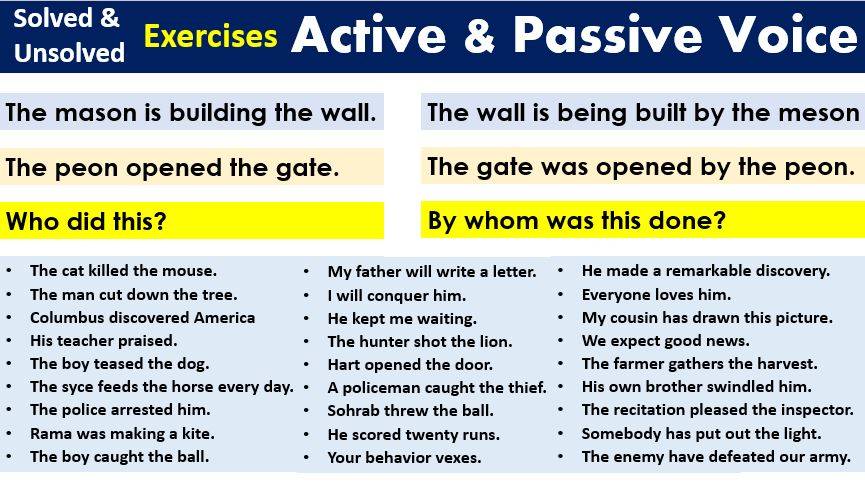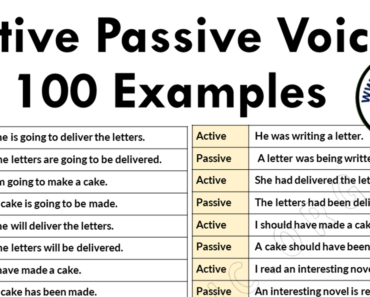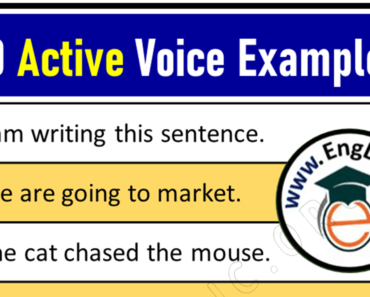Voice is one of the most important concepts to understand when learning grammar. It can be difficult to keep track of when to use the active and passive voice and how to structure sentences correctly. This article will provide a comprehensive overview of active and passive voice, including examples, rules, and some helpful tips.
We will discuss the differences between active and passive voice, how to identify them in sentences, and what role each plays in writing.
Definition of Active and Passive Voice
First, let’s define active and passive voices. The active voice is a verb tense in which the subject of a sentence performs the action.
For example, “The dog barks” is an example of an active voice.
In contrast, the passive voice is a verb tense in which the subject of a sentence does not perform the action. Instead, the action is performed on the subject.
For example, “The dog was barked at by a stranger” is an example of the passive voice.
Rules to Make Passive Voice Sentences
Passive voice is a type of sentence structure in which the subject of the sentence receives the action. In passive-voice sentences, the focus is on the action or the result of the action, rather than the person or thing performing the action. The basic formula for a passive voice sentence is:
[Object] + [verb phrase in the passive voice] + [optional agent]
Here are the rules for making passive-voice sentences:
1. The object of the active voice sentence becomes the subject of the passive voice sentence. In passive voice, the subject is the receiver of the action rather than the doer. Therefore, the object of the active voice sentence becomes the subject of the passive voice sentence.
Example:
Active voice: The cat chased the mouse.
Passive voice: The mouse was chased by the cat.
2. The verb is changed to a passive form: To create a passive sentence, the verb in the active sentence must be changed to a passive form. The passive form is made by using the appropriate form of the verb ‘to be’ and the past participle of the main verb.
Example:
Active voice: The chef cooked the meal.
Passive voice: The meal was cooked by the chef.
3. Include the agent (optional): The agent is the person or thing that performs the action in the active voice sentence. In passive voice, the agent is optional and can be included with the preposition ‘by.’
Example:
Active voice: The teacher corrected the papers.
Passive voice: The papers were corrected by the teacher.
4. Maintain the tense of the active sentence. The tense of the active voice sentence should be maintained in the passive voice sentence. Therefore, if the active sentence is in the present tense, the passive sentence should also be in the present tense.
Example:
Active voice: The company is launching a new product.
Passive voice: A new product is being launched by the company.
5. Use passive voice when the doer of the action is unknown or unimportant. Passive voice is used when the doer of the action is unknown or unimportant. This is often the case in scientific or technical writing, where the focus is on the action rather than the person performing the action.
Example:
Active voice: The hacker stole my personal information.
Passive voice: My personal information was stolen by the hacker.
6. Use passive voice when the doer of the action is obvious or already known. Passive voice is also used when the doer of the action is obvious or already known to the listener or reader. In this case, the focus of the sentence is on the action itself, rather than on the doer.
Example:
Active voice: The President will sign the bill.
Passive voice: The bill will be signed by the President.
7. Use passive voice to sound more formal or objective. Passive voice is often used in formal writing, such as academic or business writing, to sound more objective and less personal. It can make the writing sound more formal and detached.
Example:
Active voice: I conducted the experiment.
Passive voice: The experiment was conducted by me.
8. Use passive voice when you want to emphasize the action or the result. Passive voice is also used when you want to emphasize the action or the result of the action, rather than the person performing the action. It can help to put the focus on what happened, rather than who did it.
Example:
Active voice: The storm destroyed the bridge.
Passive voice: The bridge was destroyed by the storm.
9. Avoid overusing passive voice. While passive voice can be useful in certain situations, it can also make writing sound dull and lifeless if used too often. It’s important to use a mix of passive and active voices to keep writing interesting and engaging.
Example:
Active voice: The team won the championship.
Passive voice: The championship was won by the team. (overuse of passive voice)
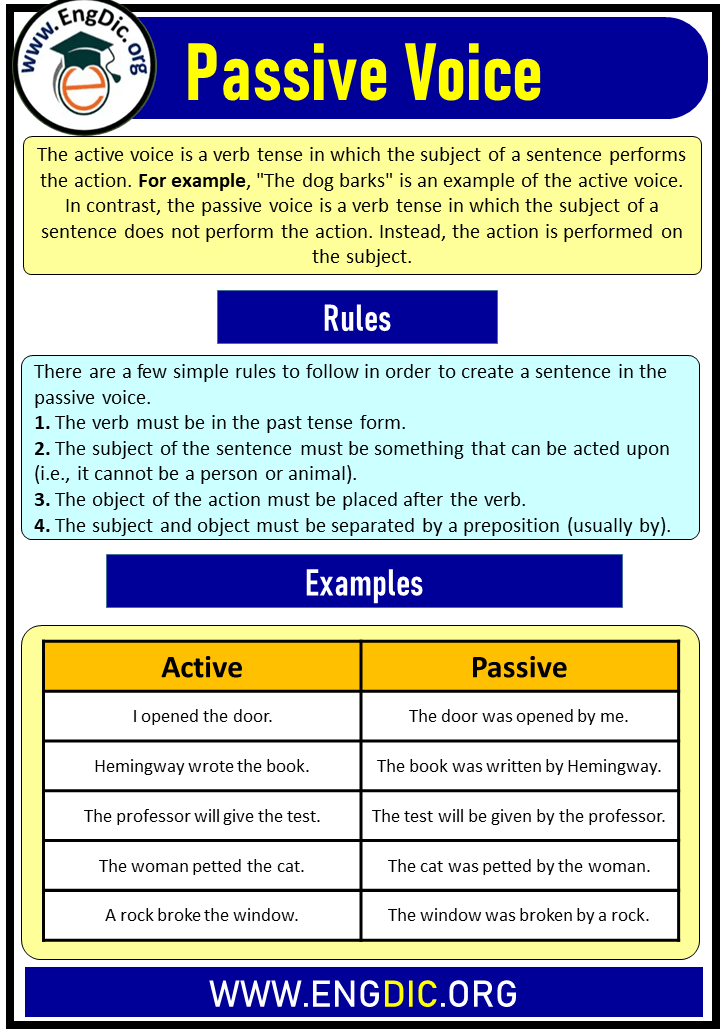
Examples of Active & Passive Voice Sentences
Below are some examples of active and passive voice sentences.
Active: The chef cooks the meal.
Passive: The meal is cooked by the chef.
Active: The artist paints a beautiful picture.
Passive: A beautiful picture is painted by the artist.
Active: The gardener waters the plants.
Passive: The plants are watered by the gardener.
Active: The teacher explains the lesson.
Passive: The lesson is explained by the teacher.
Active: The dog chases the cat.
Passive: The cat is chased by the dog.
Active: The bee pollinates the flower.
Passive: The flower is pollinated by the bee.
Active: The children play games.
Passive: Games are played by the children.
Active: The author writes a new book.
Passive: A new book is written by the author.
Active: The bird sings a song.
Passive: A song is sung by the bird.
Active: The mechanic fixes the car.
Passive: The car is fixed by the mechanic.
Active: The photographer takes a photo.
Passive: A photo is taken by the photographer.
Active: The baker bakes the bread.
Passive: The bread is baked by the baker.
Active: The student answers the question.
Passive: The question is answered by the student.
Active: The fisherman catches the fish.
Passive: The fish is caught by the fisherman.
Active: The runner wins the race.
Passive: The race is won by the runner.
Active: The mother hugs her child.
Passive: The child is hugged by the mother.
Active: The sun melts the snow.
Passive: The snow is melted by the sun.
Active: The wind moves the leaves.
Passive: The leaves are moved by the wind.
Active: The customer orders a coffee.
Passive: A coffee is ordered by the customer.
Active: The player kicks the ball.
Passive: The ball is kicked by the player.

Exercise of Active & Passive Voice Sentences
Check our detailed lesson on active passive voice exercises, here.
Exercise 1:
Rewrite the following sentence in the active voice:
1) The test was given by the professor.
2) The window was broken by a rock.
3) The cat was petted by the woman.
4) The door was opened by me.
Answers:
1) The professor gave the test.
2) A rock broke the window.
3) The woman petted the cat.
4) I opened the door.
Exercise 2:
Rewrite the following sentences in passive voice:
1) She makes the tea.
2) I open the door.
3) He hit me.
4) They sell ice cream.
Answers:
1) The tea is made by her.
2) The door is opened by me.
3) I am hit by him.
4) Ice cream is sold by them.


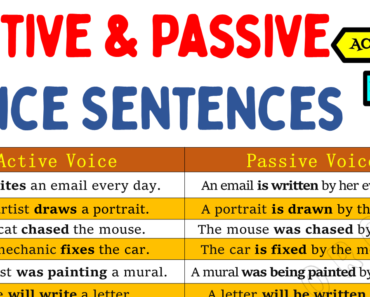
![200 Active and Passive Voice Examples with Answers [+PDF] 200 Active and Passive Voice Examples with Answers [+PDF]](https://engdic.org/wp-content/uploads/2022/03/200-Active-and-Passive-Voice-Examples-370x297.png)
